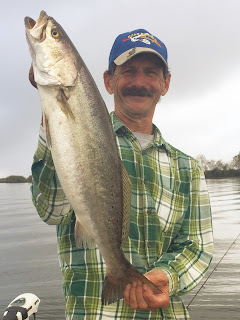Freezing Redfish
No, this blog is not about storing redfish in your freezer. This blog is about when the temps drop below that 32 degree mark, how you can load the boat with some beautiful reds. It's like clockwork, when late fall and early winter rolls around. There are times you can count on catching easy limits of redfish. It happens every year. Typically the first few freezes are the best. What happens when those first few strong cold fronts blow threw is that the strong north winds blow the water out of the marsh. This causes the many types of baitfish to move to deeper and warmer waters. These waters are many bayous located throughout south Louisiana. The many oilfield canals tend to be deeper in the back end where wellheads are located or used to be located. There you will find baitfish concentrated and where the redfish will be foraging on them. While many fishers use market shrimp or live minnows, no live bait is needed when this occurs. Under certain conditions the redfish will be very active and in a feeding frenzy, gorging themselves on the abundant baitfish. The best case scenario is when the weather has been cold but not quite to that freezing mark. The fish have a chance to acclimate themselves to the lower water temperatures and when it does drop, the fish tend to be more active. There are times when there is a dramatic change when the temps drop in the 20s or lower that the fish become lethargic and unfortunately at times, may even kill the fish. The best case for picking the right day, is to be there on the first day or two after a front that results in temperatures in the low 30s. Typically it is a short window to catch them stacked up in the many dead-ends. Once the water starts to come back in and fills the marsh again, the fish will scatter back into the marsh or lakes. You hear stories all the time that, "They were here yesterday" and this is true for wintertime red fishing. Being there on the right day is imperative.
Although live bait is the choice of most fishers, it is not necessary. However, that being said, when the fish have gorged themselves and become finicky, live bait such as shrimp or minnows may be the only thing they will hit. But for those fishers who love artificial bait, that can be as effective as live bait. Normally when the water is ice cold, you will need to slow your presentation down to a crawl. Sometimes just letting the bait sit on the bottom and slowing lifting the rod tip to make it bounce off the bottom is the best technique. Other times it may be just a slow and steady retrieve. Once the sun heats up the water, the fish may become more active and a faster retrieve can be effective.
Bait colors and size all depend on conditions. If the fish are active and feeding on shad or mullet, a normal 1/8th ounce jig head with a tout in any color and chartreuse usually works well. Sometimes, especially when the fish are feeding on micro sized minnows, downsizing may make the difference in catching fish or not. Going to a 1/16oz jig using a small tail made for panfishing can be very effective. The problem arises trying to cast these light weight lures with saltwater gear. The key is to downsize your rod and reel with either a small 1000 series spinning reel or to use a spincast reel. The spinning reel is always the better option because the drag system tends to be more efficient. If you are really ambitious and want to have fun catching big reds on uncommon gear, use a 10 or 12 foot crappie pole equipped with a small spinning reel.
Regardless of your style of fishing, next time a cold front blows through and you want to have some fantastic redfish action, bundle up and head to one of the many dead-end bayous in south Louisiana. Good luck fishing. Hope to see ya on the water.





Comments
Post a Comment